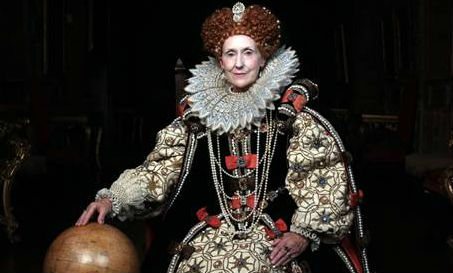 On this day in history, 19th May 1554, the 18th anniversary of her mother Anne Boleyn's execution at the Tower of London, the future Elizabeth was released from her prison in the Tower of London and placed under house arrest.
On this day in history, 19th May 1554, the 18th anniversary of her mother Anne Boleyn's execution at the Tower of London, the future Elizabeth was released from her prison in the Tower of London and placed under house arrest.
Nobody knows what was going through Elizabeth’s mind as she left the Tower on the anniversary of her mother’s execution, but being released from the Tower was not a relief for the young woman as she feared that she was going to be assassinated on her way to Woodstock, where she was going to be placed under house arrest.
The twenty-year-old Elizabeth had been taken to the Tower on 18th March 1554, Palm Sunday. We can only imagine the sheer terror she felt when Mary I’s council turned up at her doorstep on the 16th March to formally charge her with being involved in Wyatt’s Rebellion, the revolt which had taken place in January and February 1554. Elizabeth was told that Mary wanted her sister taken to the Tower for questioning and that she would be escorted there the next day.
On the 17th March 1554 two of Mary I’s councillors, Winchester and Sussex, arrived to escort Elizabeth to her prison by water. This was when Elizabeth wrote what David Starkey calls “the letter of her life”, the famous Tide Letter, so-called because as Elizabeth wrote this letter to her sister the tide turned, making it impossible to take Elizabeth to the Tower that day. Elizabeth’s delay tactics gave her a few more hours at home but the words of her letter fell on deaf ears, Mary was determined to see her sister taken to the Tower and interrogated. Click here to read a transcript of the Tide Letter.
On Palm Sunday, Elizabeth was taken from Whitehall to the Tower of London by boat, along the Thames. According to “The Miraculous Preservation of the Lady Elizabeth, now Queen of England”, a tract which was added to John Foxe’s famous “Book of Martyrs” ( or “Acts and Monuments”), when the boat landed at Traitor’s Gate Elizabeth refused to budge and when she finally did get up and get out of the boat she said:
“Here landeth as true a subject, being prisoner, as ever landed at these stairs.”
Wonderful words but, as David Starkey points out, Elizabeth did not enter the Tower through Traitors Gate as it was low tide, instead, she was taken to Tower Wharf. Although “The Miraculous Preservation” refers to Elizabeth’s prison as a “dungeon” and some books and websites state that Elizabeth was imprisoned in the Bell Tower, Starkey writes of how Elizabeth was imprisoned in the royal palace in the inner ward of the Tower of London, the palace which had been renovated by her father, Henry VIII, for her mother Anne Boleyn’s coronation but also the place where her mother had been imprisoned before her execution. Elizabeth may well have had luxurious accommodation and around a dozen servants, but she was a prisoner and must have felt that she was surely going to end her days in the Tower just like her mother, executed as a traitor.

On Good Friday, Elizabeth was interrogated by the Queen’s council. Wyatt had refused to implicate Elizabeth in his plot so the council were hoping that Elizabeth would break and provide them with the evidence they needed to get rid of her. Elizabeth did not, she kept her wits about her.
Wyatt was executed on the 11th April and instead of implicating Elizabeth he gave a rousing speech proclaiming her innocence. Wyatt’s execution must have shaken Elizabeth to the core but still she would not admit her guilt. There was no firm evidence against her and she was the daughter of the country’s beloved Bluff King Hal, there was likely to be trouble if Elizabeth was put on trial. Starkey writes of how Mary’s council “bickered and debated” over Elizabeth and Mary herself “dithered”. Mary must have been concerned about the threat which Elizabeth posed but Elizabeth was her half-sister, her flesh and blood.
As a result of all of this uncertainty, Elizabeth was granted more freedom and, although still a prisoner, was permitted to walk in the palace’s privy garden. The story in “The Miraculous Preservation” of a boy bringing flowers to Elizabeth and Elizabeth’s fellow prisoner trying to communicate with her through this boy (the son of an officer of the Tower) is actually true as it is confirmed in a report by Simon Renard to the Queen. I love the way this true story is used in “Virgin and the Crab” as John Dee’s way to communicate to Elizabeth through the flowers, using the meanings of the flowers which he once taught her to make messages – wonderful! Elizabeth was also permitted to walk in the great gallery and this extra “freedom” must have given Elizabeth hope that Mary was going to release her and spare her life. Did she dare hope?
Elizabeth’s hopes were dashed when the new Constable of the Tower, Sir Henry Bedingfield, was ordered on the 4th May 1554 to raise a hundred troops. Elizabeth must have been truly terrified to see all of these new guards – surely this meant that she was going to be executed and that these guards were for crowd control. However, Mary had decided to release her sister from the Tower and place her under house arrest. On the 19th May, the anniversary of her mother’s execution, Elizabeth was escorted from the Tower and taken by water to Richmond.

Was Elizabeth relieved and happy? No. Starkey writes of how that night at Richmond was “one of the most disturbed nights of her life” because Elizabeth was convinced that she was going to be assassinated. “For this night, I think to die” is what she told her gentleman usher and I can understand her feeling this way – it would be convenient for Mary if Elizabeth was dispatched by an intruder, something that Mary could not be held accountable for.
After an awful night at Richmond, Elizabeth was taken to Woodstock in Oxfordshire, a journey which took 4 days and a journey which showed Elizabeth’s popularity as people lined the streets to see her and her litter became laden with gifts. It was at Woodstock that she was going to be put under house arrest and carefully watched, it was not really freedom was it? Elizabeth was quite aware of this and, in a message to her servants, she referred to a verse from St Matthew’s Gospel:
“Behold, I send you forth as sheep in the midst of wolves; be ye therefore wise as serpents, and harmless as doves.”
Elizabeth knew that both she and her servants would have to keep their wits about them if they were to survive, her enemies would be watching.
Sources
- Starkey, David (2001) Elizabeth: Apprenticeship



I have often wondered whether, Elizabeth’s release from the tower on this day was by accident or design.
I’m leaning towards the idea, that Mary allowing Elizabeth ‘s release from the tower, was a way of telling her. “Be warned, if you defy me again, I will execute you as our father did your wh*re of a mother.”
I believe without a doubt that the divine hand of Almighty God was in the preservation of the protestant Queen Elizabeth 1, to start to pave the way for freedom from Catholic Europe and latin masses to allow the English speaking people to be able to read and understand the Bible in their own tongue.